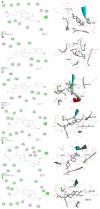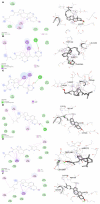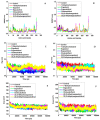Deciphering the Potential of Pre and Pro-Vitamin D of Mushrooms against Mpro and PLpro Proteases of COVID-19: An In Silico Approach
- PMID: 36080385
- PMCID: PMC9458008
- DOI: 10.3390/molecules27175620
Deciphering the Potential of Pre and Pro-Vitamin D of Mushrooms against Mpro and PLpro Proteases of COVID-19: An In Silico Approach
Abstract
Vitamin D's role in combating the SARS-CoV-2 (severe acute respiratory syndrome coronavirus 2), the virus causing COVID-19, has been established in unveiling viable inhibitors of COVID-19. The current study investigated the role of pre and pro-vitamin D bioactives from edible mushrooms against Mpro and PLpro proteases of SARS-CoV-2 by computational experiments. The bioactives of mushrooms, specifically ergosterol (provitamin D2), 7-dehydrocholesterol (provitamin-D3), 22,23-dihydroergocalciferol (provitamin-D4), cholecalciferol (vitamin-D3), and ergocalciferol (vitamin D2) were screened against Mpro and PLpro. Molecular docking analyses of the generated bioactive protease complexes unravelled the differential docking energies, which ranged from -7.5 kcal/mol to -4.5 kcal/mol. Ergosterol exhibited the lowest binding energy (-7.5 kcal/mol) against Mpro and PLpro (-5.9 kcal/mol). The Molecular Mechanics Poisson-Boltzmann Surface Area (MMPBSA) and MD simulation analyses indicated that the generated complexes were stable, thus affirming the putative binding of the bioactives to viral proteases. Considering the pivotal role of vitamin D bioactives, their direct interactions against SARS-CoV-2 proteases highlight the promising role of bioactives present in mushrooms as potent nutraceuticals against COVID-19.
Keywords: SARS-CoV-2; edible mushrooms; in-silico studies; pre-vitamin-D; pro-vitamin-D.
Conflict of interest statement
The authors declare no conflict of interest.
Figures





Similar articles
-
SARS-CoV-2 proteases Mpro and PLpro: Design of inhibitors with predicted high potency and low mammalian toxicity using artificial neural networks, ligand-protein docking, molecular dynamics simulations, and ADMET calculations.Comput Biol Med. 2023 Feb;153:106449. doi: 10.1016/j.compbiomed.2022.106449. Epub 2022 Dec 23. Comput Biol Med. 2023. PMID: 36586228 Free PMC article.
-
Identification of potent COVID-19 main protease inhibitors by loading of favipiravir on Mg12O12 and Zn12O12 nanoclusters: an in silico strategy for COVID-19 treatment.J Biomol Struct Dyn. 2023;41(21):11437-11449. doi: 10.1080/07391102.2022.2162967. Epub 2023 Jan 2. J Biomol Struct Dyn. 2023. PMID: 36591698
-
Black tea bioactives as inhibitors of multiple targets of SARS-CoV-2 (3CLpro, PLpro and RdRp): a virtual screening and molecular dynamic simulation study.J Biomol Struct Dyn. 2022 Sep;40(15):7143-7166. doi: 10.1080/07391102.2021.1897679. Epub 2021 Mar 10. J Biomol Struct Dyn. 2022. PMID: 33715595
-
Critical Review of Plant-Derived Compounds as Possible Inhibitors of SARS-CoV-2 Proteases: A Comparison with Experimentally Validated Molecules.ACS Omega. 2022 Dec 2;7(49):44542-44555. doi: 10.1021/acsomega.2c05766. eCollection 2022 Dec 13. ACS Omega. 2022. PMID: 36530229 Free PMC article. Review.
-
SARS-CoV-2 proteins show great binding affinity to resin composite monomers and polymerized chains.World J Exp Med. 2025 Mar 20;15(1):94022. doi: 10.5493/wjem.v15.i1.94022. eCollection 2025 Mar 20. World J Exp Med. 2025. PMID: 40115751 Free PMC article. Review.
Cited by
-
The Efficacious Benefit of 25-Hydroxy Vitamin D to Prevent COVID-19: An In-Silico Study Targeting SARS-CoV-2 Spike Protein.Nutrients. 2022 Nov 23;14(23):4964. doi: 10.3390/nu14234964. Nutrients. 2022. PMID: 36500994 Free PMC article.
-
Edible mushrooms trending in food: Nutrigenomics, bibliometric, from bench to valuable applications.Heliyon. 2024 Aug 27;10(17):e36963. doi: 10.1016/j.heliyon.2024.e36963. eCollection 2024 Sep 15. Heliyon. 2024. PMID: 39281488 Free PMC article. Review.
-
Progress in SARS-CoV-2, diagnostic and clinical treatment of COVID-19.Heliyon. 2024 Jun 17;10(12):e33179. doi: 10.1016/j.heliyon.2024.e33179. eCollection 2024 Jun 30. Heliyon. 2024. PMID: 39021908 Free PMC article. Review.
References
MeSH terms
Substances
Grants and funding
LinkOut - more resources
Full Text Sources
Miscellaneous

